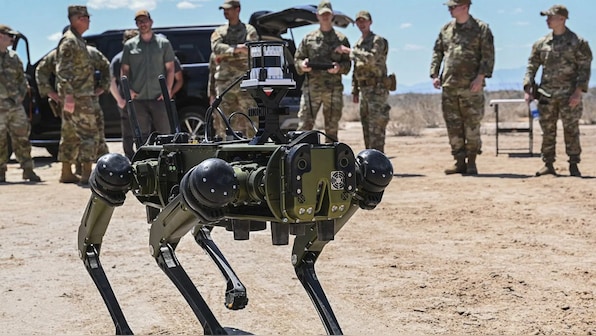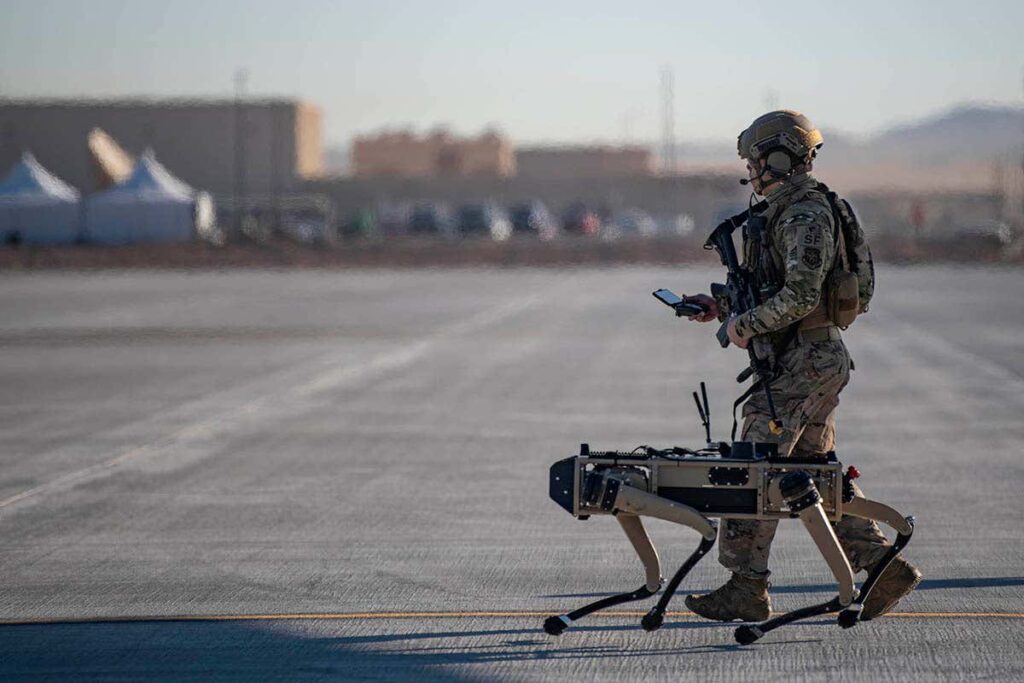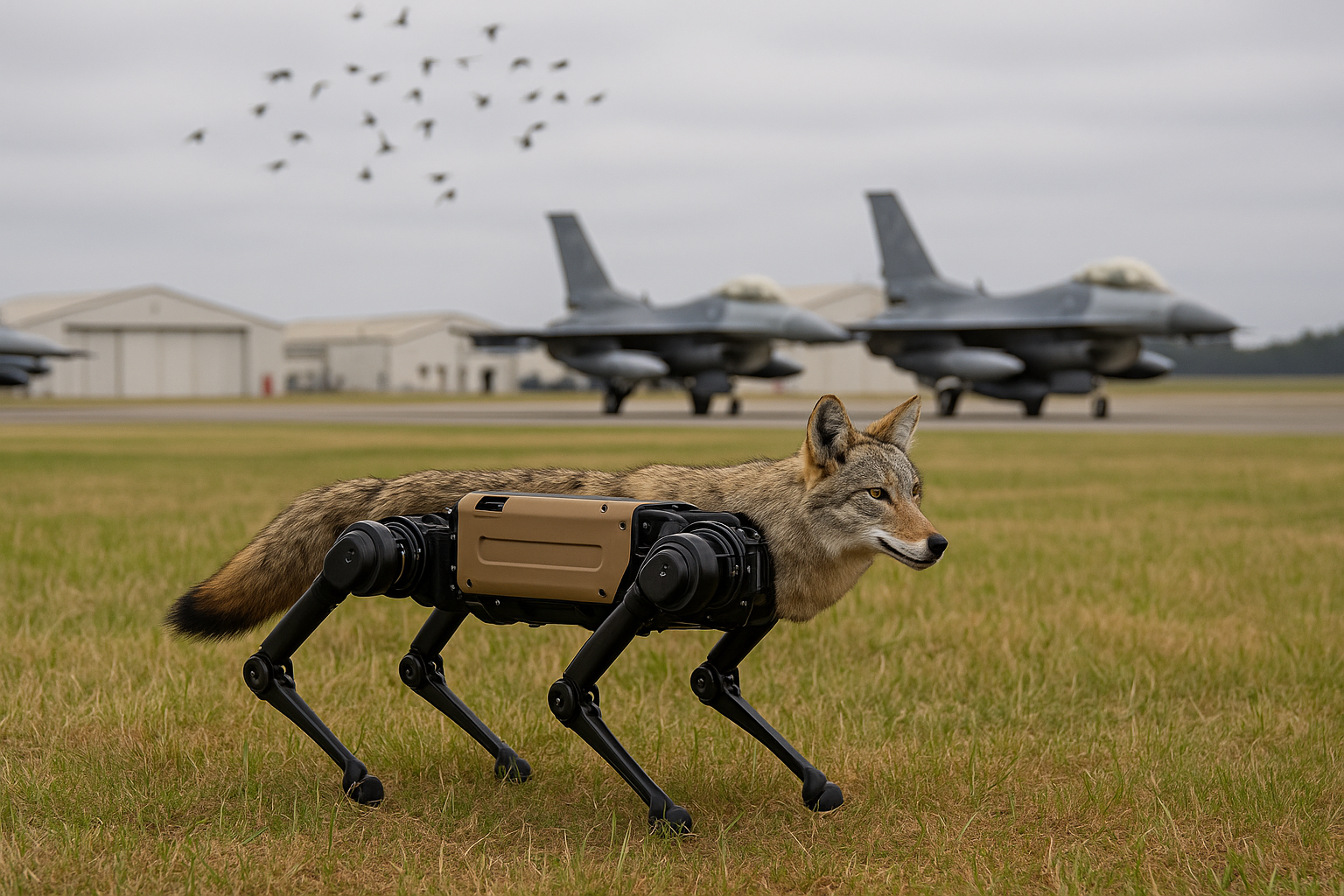In a groundbreaking military innovation blending robotics, wildlife deterrence, and aviation safety, the U.S. Army is testing robotic coyotes to protect its fighter jets from bird strikes an unconventional solution to a decades old, multimillion dollar problem. The idea of using unmanned ground vehicles (UGVs) to mimic predators might seem like a scene from a sci-fi movie, but it’s a real and urgent response to an invisible threat birds.
Every year, bird strikes cost the U.S. military millions of dollars in damages and endanger the lives of pilots. According to the Air Force Safety Center, there were more than 4,000 reported wildlife strikes in 2023 alone. The U.S. Army Corps of Engineers’ Engineer Research and Development Center (ERDC) has decided to fight this threat with cutting edge tech in the form of robotic coyotes an innovative solution with serious implications.
Why Fighter Jets Need Protection from Birds
The power and speed of modern fighter jets come with a critical vulnerability wildlife. Birds near runways or airfields pose a serious hazard. When a bird is sucked into an aircraft engine during takeoff or landing, it can cause catastrophic engine failure. This isn’t just theoretical; it’s a proven danger.
The F-16 Bird Strike Incident
In 2019, an F-16 fighter jet stationed at Shaw Air Force Base in South Carolina collided with a bird shortly after takeoff. The damage led to a crash in a remote area, causing the loss of a $22 million jet. Thankfully, the pilot ejected safely, but the incident underlined the deadly risk wildlife poses to military aviation.
This is where robotic coyotes enter the battlefield not against enemies, but against nature.

How Robotic Coyotes Work
The ERDC’s robotic coyotes are sophisticated unmanned ground vehicles (UGVs) equipped with AI driven navigation, movement mimicking, and even sound generation that replicates real predator behaviors. The goal is to create a consistent deterrent across airfields, scaring off birds and small mammals that might otherwise find refuge near runways.
Unlike static scarecrows or noise based repellents that birds quickly get used to, robotic coyotes roam freely, adapt to their environment, and simulate hunting behavior. Their mobility and unpredictability make them more effective over time.
A New Era in Wildlife Deterrence
Dr. Amanda Scott, a senior researcher in aeronautical safety at MIT, praises the initiative-
“Using robotic coyotes combines animal behavior science with robotics to solve a persistent aviation problem. It’s a proactive rather than reactive solution, potentially saving lives and millions in aircraft repairs.”
Similarly Captain Drew Thomas, a retired F-15 pilot, highlights the psychological comfort these systems could provide to pilots-
“As a pilot, every takeoff is a risk. Knowing that your runway is protected by robotic patrols simulating predators? That’s a new kind of safety net.”
The Tech Behind the Innovation
These robotic coyotes are designed with:
AI and LIDAR sensors for smart pathfinding, Thermal and acoustic sensors to detect wildlife nearby, Solar charged power systems for sustainability, Realistic design and movement to mimic actual coyotes, Remote control override in case of anomalies.
They are not just scarecrows on wheels they’re autonomous machines with real time decision making ability. By leveraging AI, the system learns bird behavior over time, adapting its patrol routes and timing to stay unpredictable.
On the Ground With the Prototype
In a recent demonstration at an undisclosed military airbase in Texas, engineers ran a full field test. Staff Sergeant Miguel Alvarez, who helped oversee the live trial, reported-
“We were skeptical at first, but within 10 minutes of deployment, birds started dispersing. It’s eerily effective. The movement, the posture it looks like a real predator.”
Even the base’s wildlife biologist, who had tried lasers and loudspeakers for years, said the robotic coyotes had immediate impact where traditional methods failed.
Advantages Over Traditional Wildlife Control
Loudspeaker noise systems Visual, sound, and movement based, Falconry (trained birds) Autonomous, no live animal needed
Fencing Dynamic deterrence over wide area, The use of robotic coyotes isn’t just another tool it represents a full rethinking of how military facilities can interface with nature responsibly and effectively.

Environmental and Ethical Considerations
Interestingly robotic solutions like these reduce the need for lethal wildlife control methods such as trapping or poisoning. They offer an eco-friendly, non-violent solution that respects both aircraft safety and animal life.
Wildlife protection agencies have cautiously welcomed the development, provided it’s used transparently and within ethical limits. Robotic deterrents must avoid harming actual animals something the developers are acutely aware of.
Wider Applications Beyond Airfields
Although developed for military use, the potential for robotic coyotes extends far beyond airbases. Civilian airports, agricultural zones, and even renewable energy farms plagued by bird activity could benefit.
Dr. Lawrence Hunt, a robotics specialist at Stanford University, says, “What’s exciting is the scalability. This could be an exportable model, used anywhere from JFK Airport to wind farms in rural Montana.”
As the U.S. Army tests and refines these robotic coyotes, the question is no longer if but when they’ll become a standard fixture on military runways. The success of these field trials could shape how both military and civilian aviation manage wildlife hazards in the coming decades.
In an era where drones dominate airspace and AI revolutionizes ground defense, the robotic coyote stands out not as a weapon, but as a protector.
It’s a stark reminder that sometimes, defending the future of aviation requires looking back at nature’s own strategies and enhancing them with the precision of robotics.
The robotic coyotes tested by the U.S. Army symbolize the merging of innovation and necessity. In defending billion dollar fighter jets and their brave pilots, this unusual fusion of predator mimicry and autonomous systems may become the norm in airfield safety worldwide.
By addressing a silent yet significant threat with technological brilliance and ecological mindfulness, these robotic coyotes may just prove that when it comes to aviation safety, even sci-fi-sounding ideas have real world power.


1 thought on “Army Tests Robotic Coyotes to Defend Fighter Jets”